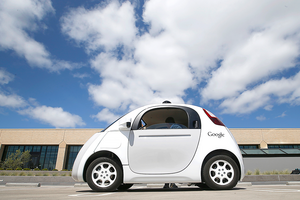Google's self-driving cars still need humans, says company report
Between September 2014 and November 2015, Google’s fleet of autonomous vehicles clocked 424,331 miles on California public roads. During those trips, a report reveals, human beings needed to grab the wheel 69 times to avoid possible accidents.

Google's new self-driving prototype car is presented during a demonstration at the Google campus in Mountain View, Calif. The self-driving cars needed some old-fashioned human intervention to avoid some crashes during testing on California roads, the company revealed onTuesday.
Tony Avelar/AP/File
Google aims to release its self autonomous cars to the public by 2020 but, as of today, the company’s self-driving cars still need human intervention to avoid software failures and prevent car accidents.
The company filed a new report with California’s Department of Motor Vehicles on Tuesday that documented the number of times the test drivers of the cars had to manually take control of the cars – in what is referred as “disengagement” – to ensure safety
The report showed that from September 2014 to November 2015, there were 341 disengagements in total, 272 of which were caused by technical related glitches, while the remaining 69 resulted from instances where the test drivers grabbed the wheel to avoid possible accidents.
The disengagements did not necessarily stem from dangerous situations, according to the company. The report says that the threshold for the “immediate manual control” is set conservatively, because they are trying to collect as much data as possible to improve self-driving cars before they release them to the public.
The report shows that 272 of the disengagements resulted from hardware issue such as broken wires and software issues such as a faulty GPS. In 13 of the 69 incidences where the test drivers manually grabbed the wheel, they did so to avoid possible collision with careless drivers and pedestrians on the roads. The drivers received audio and visual signals to alert them when the car was about to disengage, and took control of the car in an average of 0.84 seconds.
The company is focused on making fully autonomous self-driving cars, unlike Tesla and General Motors, which are starting with partially autonomous systems and aims to gradually upgrade them over a period of time.
“The industry has been making continuous incremental gains, but for self-driving cars to reach their full potential we need to focus on nothing short of full autonomy,” John Krafcik, chief executive of Google’s self-driving car, said at the Detroit Auto Show on Tuesday. “Aiming for full autonomy not only reaches the most people, our team believes it’s also the safest approach. Having this audacious goal was what drew me to the Google self-driving car project,” he added.
In December, the California's Department of Motor Vehicles rolled out regulations for the use of driverless cars on public roads. The regulations would allow the public to lease self-driving cars from companies such as Google and Tesla, but won’t allow anyone to purchase a fully autonomous car. The regulations also stated that participants would have to undergo special training in addition to having a normal license.
While the data indicates that the company is far from achieving its goal of full autonomy, the overall disengagements fell from one per 785 miles in the one per 5,318 miles during the report's time period.

